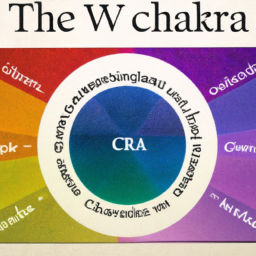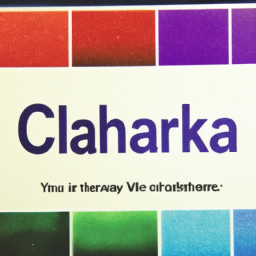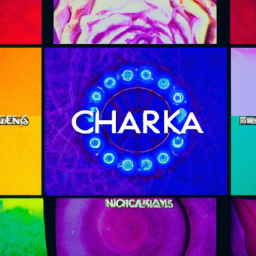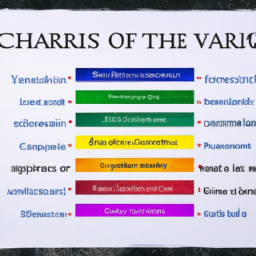Chakras, also known as energy centers, have been an integral part of Eastern spiritual traditions for centuries. The concept of chakras originated in Hinduism and has been adopted by other religions such as Buddhism, Jainism, and Sikhism. These energy centers are believed to be vital for achieving physical, mental, and spiritual well-being. In this article, we will explore the association between chakras and various religions.
Hinduism
In Hinduism, chakras are believed to be the seven energy centers that run along the spine, starting from the base of the spine to the crown of the head. Each chakra is associated with a specific color, element, and deity. The seven chakras are:
- Muladhara (Root) Chakra: located at the base of the spine and associated with the color red, the element Earth, and the deity Lord Ganesha.
- Swadhisthana (Sacral) Chakra: located at the lower abdomen and associated with the color orange, the element Water, and the deity Goddess Saraswati.
- Manipura (Solar Plexus) Chakra: located at the abdomen and associated with the color yellow, the element Fire, and the deity Lord Vishnu.
- Anahata (Heart) Chakra: located at the center of the chest and associated with the color green, the element Air, and the deity Lord Shiva.
- Vishuddha (Throat) Chakra: located at the throat and associated with the color blue, the element Ether, and the deity Goddess Radha.
- Ajna (Third Eye) Chakra: located between the eyebrows and associated with the color indigo, the element Light, and the deity Lord Brahma.
- Sahasrara (Crown) Chakra: located at the top of the head and associated with the color violet, the element Cosmic Energy, and the deity Lord Surya.
Hinduism views the chakras as the pathway to spiritual enlightenment and achieving a higher state of consciousness. It is believed that by balancing and activating these energy centers, one can achieve harmony of mind, body, and soul.
Buddhism
Buddhism, like Hinduism, also acknowledges the seven chakras, but with slight variations in their names and attributes. In Buddhism, the chakras are known as Dantian and are associated with the flow of Qi (life force energy) in the body. The seven dantian are:
- Qian Dantian (Upper Dantian): located at the forehead and associated with the color white and the element Yin.
- Zhong Dantian (Middle Dantian): located at the chest and associated with the color red and the element Yang.
- Hou Dantian (Rear Dantian): located at the back of the head and associated with the color blue and the element Jing.
- Yin Dantian (Hidden Dantian): located at the lower abdomen and associated with the color yellow and the element Qi.
- Renzhong Dantian (Human Middle Dantian): located at the center of the torso and associated with the color green and the element Shen.
- Cao Dantian (Grass Dantian): located at the lower belly and associated with the color white and the element Hun.
- Hunyuan Dantian (Primordial Dantian): located at the lower abdomen and associated with the color black and the element Yuan Qi.
In Buddhism, the chakras are seen as a means to achieve spiritual liberation and inner peace. By balancing and meditating on the dantian, one can overcome negative emotions and attain a higher state of consciousness.
Jainism
Jainism, a religion that originated in ancient India, also recognizes the significance of chakras for spiritual growth. According to Jainism, there are nine energy centers in the body, instead of the traditional seven. These nine chakras are associated with the following:
- Ajiva Chakra (Material Energy Center): located at the center of the body and associated with the element Air.
- Jiva Chakra (Spiritual Energy Center): located at the center of the forehead and associated with the element Fire.
- Chaitanya Chakra (Consciousness Energy Center): located at the base of the skull and associated with the element Moon.
- Mind Molecule Chakra: located between the eyebrows and associated with the element Sun.
- Dharma Chakra (Righteous Energy Center): located at the throat and associated with the element Sky.
- Bhava Chakra (Emotional Energy Center): located at the heart and associated with the element Space.
- Karma Chakra (Action Energy Center): located at the navel and associated with the element Ocean.
- God Particle Chakra: located at the tip of the nose and associated with the element Agni.
- Mantra Chakra: located at the center of the tongue and associated with the element Mantra.
Jainism views the chakras as a means to eliminate karmic blockages and attain a state of pure consciousness. By meditating and focusing on these energy centers, individuals can gain spiritual liberation and reach a state of inner peace and enlightenment.
Sikhism
Sikhism, a monotheistic religion founded in the 15th century, also acknowledges the presence of chakras in the body. In Sikhism, the chakras are known as Khoras and are associated with the flow of energy in the body. The five Khoras are:
- Shabad Khor (Sound Chakra): located at the ear and associated with the sound energy.
- Anahata Khor (Heart Chakra): located at the heart and associated with the breath energy.
- Bhagauti Khor (Ego Chakra): located at the throat and associated with the ego energy.
- Hirankar Khor (Mind Chakra): located at the forehead and associated with the mind energy.
- Dasam Dwar Khor (Third Eye Chakra): located at the center of the forehead and associated with the cosmic energy.
In Sikhism, the chakras are seen as a means to connect with the divine and achieve spiritual enlightenment. By focusing on the Khoras and meditating on the divine, individuals can attain inner peace and a deeper understanding of the teachings of Sikhism.
Conclusion
In conclusion, chakras are intertwined with various religions and hold a significant role in their spiritual practices. While the names and attributes of chakras may vary in different religions, the belief in their existence and their ability to heal the mind, body, and soul remains constant. Regardless of one’s religious beliefs, chakras serve as a pathway to achieving spiritual growth and inner harmony.
Whether you are a follower of Hinduism, Buddhism, Jainism, or Sikhism, understanding and balancing your chakras can enhance your overall well-being and lead you on a journey towards spiritual enlightenment. So, take some time to meditate on your chakras, focus on your breath, and connect with your divine energy!





Chakras are a system of energy-based spiritual beliefs and practices that originated in Hindu and Buddhist traditions. #Interesting